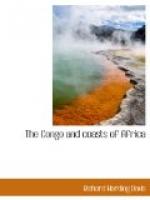The next morning we had our third and last chance at a hippo.
It is distinctly a hard-luck story. We had just gone on the bridge for breakfast when we saw him walking slowly from us along an island of white sand as flat as your hand, and on which he loomed large as a haystack. Captain Jensen was a true sportsman. He jerked the bell to the engine-room, and at full speed the Deliverance raced for the shore. The hippo heard us, and, like a baseball player caught off base, tried to get back to the river. Captain Jensen danced on the deck plates:
“Schoot it! schoot it!” he yelled, “Gotfurdamn! schoot it!” When Anfossi and I fired, the Deliverance was a hundred yards from the hippo, and the hippo was not five feet from the bank. In another instant, he would have been over it and safe. But when we fired, he went down as suddenly as though a safe had dropped on him. Except that he raised his head, and rolled it from side to side, he remained perfectly still. From his actions, or lack of actions, it looked as though one of the bullets had broken his back; and when the blacks saw he could not move they leaped and danced and shrieked. To them the death of the big beast promised much chop.
But Captain Jensen was not so confident. “Schoot it,” he continued to shout, “we lose him yet! Gotfurdamn! schoot it!”
My gun was an American magazine rifle, holding five cartridges. We now were very near the hippo, and I shot him in the head twice, and, once, when he opened them, in the jaws. At each shot his head would jerk with a quick toss of pain, and at the sight the blacks screamed with delight that was primitively savage. After the last shot, when Captain Jensen had brought the Deliverance broadside to the bank, the hippo ceased to move. The boat had not reached the shore before the boys with the steel hawser were in the water; the gangplank was run out, and the black soldiers and wood boys, with their knives, were dancing about the hippo and hacking at his tail. Their idea was to make him the more quickly bleed to death. I ran to the cabin for more cartridges. It seemed an absurd precaution. I was as sure I had the head of that hippo as I was sure that my own was still on my neck. My only difficulty was whether to hang the head in the front hall or in the dining-room. It might be rather too large for the dining-room. That was all that troubled me. After three minutes, when I was back on deck, the hippo still lay immovable. Certainly twenty men were standing about him; three were sawing off his tail, and the women were chanting triumphantly a song they used to sing in the days when the men were allowed to hunt, and had returned successful with food.
On the bridge was Anfossi with his camera. Before the men had surrounded the hippo he had had time to snap one picture of it. I had just started after my camera, when from the blacks there was a yell of alarm, of rage, and amazement. The hippo had opened his eyes and raised his head. I shoved the boys out of the way, and, putting the gun close to his head, fired pointblank. I wanted to put him out of pain. I need not have distressed myself. The bullet affected him no more than a quinine pill. What seemed chiefly to concern him, what apparently had brought him back to life, was the hacking at his tail. That was an indignity he could not brook.




